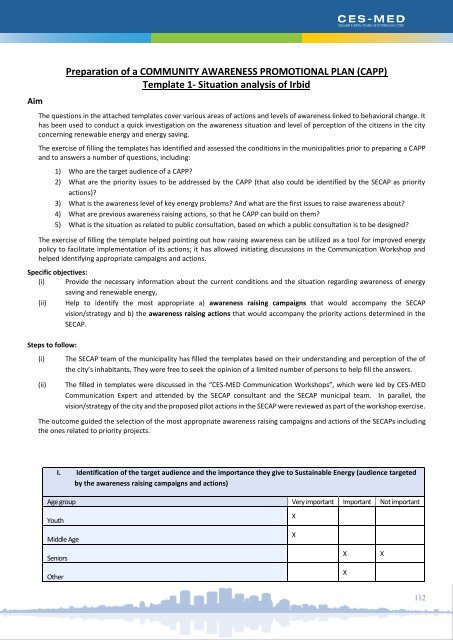171117_SECAP of Greater Irbid Municipality_SET_rev2
You also want an ePaper? Increase the reach of your titles
YUMPU automatically turns print PDFs into web optimized ePapers that Google loves.
- Grey water Reuse<br />
- Public awareness<br />
The following table explains the adaptation action related to infrastructure:<br />
Actions’ Adaptation Actions<br />
characteristic<br />
Strategic Water and waste water management plan<br />
Alert /<br />
Communicati<br />
on<br />
Educational<br />
Technical<br />
Modelling predicted supply changes in the electricity from the locally<br />
available RES sources that serve the community, as a result <strong>of</strong> the<br />
climate change<br />
Frequent monitoring <strong>of</strong> the infrastructure in order to spot and quickly<br />
repair any damages<br />
Reduce uncertainties in climatic design values, regularly updated<br />
climatic design values, enforcement <strong>of</strong> codes and standards,<br />
maintenance <strong>of</strong> climate data records and networks, consistent<br />
forensic analyses <strong>of</strong> infrastructure failures, regular maintenance<br />
scheduling and community disaster management planning.<br />
Issuing alerts in case a part <strong>of</strong> the infrastructure has been severely<br />
damaged and citizens should avoid it<br />
Developing guides and awareness raising campaigns for citizens on<br />
how to save water and energy, especially during crisis<br />
Integration <strong>of</strong> sustainable drainage systems<br />
Establishment <strong>of</strong> underground water reservoirs<br />
Building desalination plants based on the best available technologies<br />
Increase the use <strong>of</strong> renewable energy to decrease pressure on the<br />
public grid and would contribute to prevent failure <strong>of</strong> power plants<br />
Development <strong>of</strong> controlled flood management zones near afflicted<br />
Estimated cost in JOD<br />
100,000<br />
70,000,000 JOD<br />
Years <strong>of</strong> Implementation<br />
Adaptation actions for built environment<br />
The importance <strong>of</strong> adaptation actions in built environment is to improve the resilience <strong>of</strong> the built environment in the face<br />
<strong>of</strong> climate change and also will aims to protect the wellbeing <strong>of</strong> communities through targeted policy initiatives and better<br />
urban and building design, ensure appropriate institutional arrangements to facilitate adaptation, realise economic<br />
benefits from early adaptation through effective strategic planning and risk minimization, advance sustainability through<br />
better resource and risk management strategies, and increase community education and awareness about climate change<br />
risks and adaptation.<br />
Urban Sector:<br />
The Representative Concentration Pathways (RCP) is the latest generation <strong>of</strong> scenarios that provide input to climate<br />
models. Scenarios have long been used by planners and decision makers to analyse situations in which outcomes are<br />
uncertain. In climate research, emissions scenarios are used to explore how much humans could contribute to future<br />
climate change given uncertainties in factors such as population growth, economic development, and development <strong>of</strong> new<br />
technologies. Projections and scenarios <strong>of</strong> future social and environmental conditions are also used to explore how much<br />
impact lesser or greater amounts <strong>of</strong> climate change would have on different possible states <strong>of</strong> the world, for example<br />
futures with greater or lesser amounts <strong>of</strong> poverty. The purpose <strong>of</strong> using scenarios is not to predict the future, but to explore<br />
both the scientific and real-world implications <strong>of</strong> different plausible futures.<br />
According to Jordan’s Third National Communication report on Climate Change (TNC), at the kingdom level, the overall<br />
exposure in RCP 4.5 is low and moderate in RCP 8.5, although the exposure is low, the events concentrate in certain<br />
geographic areas and thus the kingdom exposure is not the best representation for specific urban areas as Amman and<br />
Salt. The main factor, which reduced the exposure score, is the confidence <strong>of</strong> occurrence due to the large geographic<br />
coverage which is not uniform in exposure. For the purpose <strong>of</strong> better representation <strong>of</strong> climate change impact on<br />
105

















